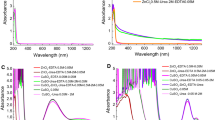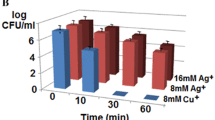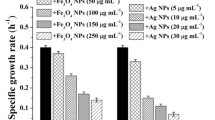Abstract
This study continues the series of experiments that demonstrate the high antibacterial properties of monovalent copper ions (Cu+). While in previous study we examined different metals (copper and silver) and their metal states (mono- and divalent), showing that monovalent copper is best for controlling bacterial growth, the current study focuses on finding conditions which further enhance the antibacterial effect of monovalent copper. This approach may also shed light on mechanisms of Cu+ ions which still remain unknown. To this end, the influence of Cu+ ions on model gram-negative Escherichia coli bacteria at different pH levels with a variety of carbon sources and elevated temperatures was examined. It was found that in both aerobic and anaerobic conditions in a poor growth medium, Cu2+ ions barely suppress any growth of E. coli, whereas Cu+ ions even at very low concentrations dramatically deplete bacterial populations in a time scale of minutes at room temperature, and less than one minute at elevated temperatures. Acidic pH, unfavorable carbon sources, and elevated temperatures boost the antibacterial action of Cu+ ions. On the whole, the study confirms that monovalent copper ions are strongly superior to divalent copper ions in their antibacterial action across a wide range of tested conditions.



Similar content being viewed by others
References
Borkow G, Gabbay J (2009) Copper, an ancient remedy returning to fight microbial, fungal and viral infections. Curr Chem Biol 3(3):272–278. https://doi.org/10.2174/187231309789054887
Borkow G, Gabbay J (2004) Putting copper into action: copper-impregnated products with potent biocidal activities. FASEB J. 18:1728–1730. https://doi.org/10.1096/fj.04-2029fje
Casey AL, Adams D, Karpanen TJ, Lambert PA, Cookson BD, Nightingale P, Miruszenko L, Shillam R, Christian P, Elliott TS (2010) Role of copper in reducing hospital environment contamination. J Hosp Infect 74:72–77. https://doi.org/10.1016/j.jhin.2009.08.018
Mikolay A, Huggett S, Tikana L et al (2010) Survival of bacteria on metallic copper surfaces in a hospital trial. Appl Microbiol Biotechnol 87(5):1875–1879. https://doi.org/10.1007/s00253-010-2640-1
Lemire J, Harrison J, Turner R (2013) Antimicrobial activity of metals: mechanisms, molecular targets and applications. Nat Rev Microbiol 11:371–384. https://doi.org/10.1038/nrmicro3028
Quaranta D, Krans T, Santo CE et al (2011) Mechanisms of contact-mediated killing of yeast cells on dry metallic copper surfaces. Appl Environ Microbiol 77(2):416–426. https://doi.org/10.1128/AEM.01704-10
Michels HT, Noyce JO, Keevil CW (2009) Effects of temperature and humidity on the efficacy of methicillin-resistant Staphyllococcus aureus challenged antimicrobial materials containing silver and copper. Lett Appl Microbiol. 49(2):191–195. https://doi.org/10.1111/j.1472-765X.2009.02637.x
Weaver L, Noyce JO, Michels HT, Keevil CW (2010) Potential action of copper surfaces on methicillin-resistant Staphylococcus aureus. J Appl Microbiol. 109(6):2200–2205. https://doi.org/10.1111/j.1365-2672.2010.04852.x
Santo CE, Quaranta D, Grass G (2012) Antimicrobial metallic copper surfaces kill Staphylococcus haemolyticus via membrane damage. Microbiologyopen 1(1):46–52. https://doi.org/10.1002/mbo3.2
Noyce JO, Michels H, Keevil CW (2006) Use of copper cast alloys to control Escherichia coli O157 cross-contamination during food processing. Appl Environ Microbiol 72:4239–4244. https://doi.org/10.1128/AEM.02532-05
Grass G, Rensing C, Solioz M (2011) Metallic copper as an antimicrobial surface. Appl Environ Microbiol. 77(5):1541–1547. https://doi.org/10.1128/AEM.02766-10
Parker AJ (1973) Copper ions in acetonitrile. Search 4:426
Parker AJ, Macleod ID, Singh P (1981) Electrochemistry of copper in aqueous acetonitrile. J Solut Chem 10(11):757–774. https://doi.org/10.1007/BF00649487
Pang J, Ritchie IM, Giles DE (1975) The kinetics of copper dissolution in acetonitrile-water copper(II) solutions. Electrochim Acta. 20(12):923–928
Saphier M, Burg A, Sheps S, Cohen H, Meyerstein D (1999) Complexes of copper(I) with aromatic compounds in aqueous solutions. J Chem Soc Dalton Trans 11:1845–1849
Domenech A et al (2000) Electrochemistry of copper complexes with polyaza[n] paracyclophanes, Influence of ATP as an exogen ligand on the relative stability of the Cu(II) and Cu(I) oxidation states. Inorg Chim Acta 299:238–246. https://doi.org/10.1016/S0020-1693(99)00506-X
Saphier M, Silberstein E, Shotland Y, Popov S, Saphier O (2018) Prevalence of monovalent copper over divalent in killing Esherichia coli and Staphylococcus aureus. Curr Microbiol 75:426–430. https://doi.org/10.1007/s00284-017-1398-4
Abboud EC, Settle JC, Legare TB, Marcet JE, Barillo DJ, Sanchez JE (2014) Silver-based dressings for the reduction of surgical site infection: review of current experience and recommendation for future studies. Burns 40(Suppl 1):S30–S39. https://doi.org/10.1016/j.burns.2014.09.011
Outten FW, Huffman DL, Hale JA, O’Halloran TV (2001) The independent cue and cus systems confer copper tolerance during aerobic and anaerobic growth in Escherichia coli. J Biol Chem. 276(33):30670–30677. https://doi.org/10.1074/jbc.M104122200
Kim C, Wilkins K, Bowers M, Wynn C, Ndegwa E (2018) Influence of pH and temperature on growth characteristics of leading foodborne pathogens in a laboratory medium and select food beverages. Food Sci Nutr. https://doi.org/10.1002/fsn3.1034
Buchanan RL, Klawitter LA (1992) The effect of incubation temperature, initial pH, and sodium chloride on the growth kinetics of Esherichia coli O157: H7. Food Microbiol 9(3):185–196. https://doi.org/10.1016/0740-0020(92)80046-7
Aidelberg G, Towbin BD, Rothschild D, Dekel E, Bren A, Alon U (2014) Hierarchy of non-glucose sugars in Escherichia coli. BMC Syst Biol. 8:133. https://doi.org/10.1186/s12918-014-0133-z
Gabriel AA. (2012) Influences of heating temperature, pH, and soluble solids on the decimal reduction times of acid-adapted and non-adapted Escherichia coli O157:H7 (HCIPH 96055) in a defined liquid heating medium Int J Food Microbiol 160 (1):50–57.https://doi.org/10.1016/j.ijfoodmicro.2012.09.004
Author information
Authors and Affiliations
Corresponding authors
Additional information
Publisher's Note
Springer Nature remains neutral with regard to jurisdictional claims in published maps and institutional affiliations.
Rights and permissions
About this article
Cite this article
Popov, S., Saphier, O., Popov, M. et al. Factors Enhancing the Antibacterial Effect of Monovalent Copper Ions. Curr Microbiol 77, 361–368 (2020). https://doi.org/10.1007/s00284-019-01794-6
Received:
Accepted:
Published:
Issue Date:
DOI: https://doi.org/10.1007/s00284-019-01794-6




